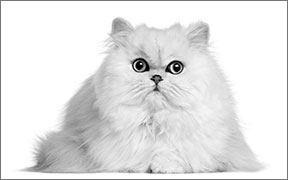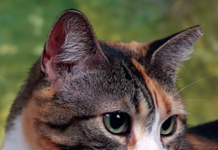If you notice your cat squinting or his eyes watering, he may be suffering from entropion, a condition that causes part of the eyelids to fold inward and eyelashes to rub on the eyes’ surface. It usually affects the lower eyelids but can also impact the upper lids, in either case causing considerable discomfort. Telltale signs may also include:

288
– Red and swollen eyelids
– Excessive blinking
– Inflammation of the eye membranes (conjunctivitis)
– Sagging skin around the eye socket
– Mucus or other discharge from the eyes
– Rubbing or pawing the eyes
“Entropion is most commonly a genetic condition with brachycephalic breeds, such as Persians and Himalayans, at higher risk because of their skull conformations,” says J. Seth Eaton, VMD, ACVO, a veterinary ophthalmology consultant and former staff ophthalmologist at Cornell University Veterinary Specialists in Stamford, Conn.
The anatomy of short-nosed breeds puts more strain on the ligaments of the eyelids than it does in other types of cats, particularly adjacent to the nose. As a result, veterinarians may detect entropion within the first year of a kitten’s life during a routine physical examination.
However, entropion can occur in any cat at any age due to chronic disease or injury to the eyes. While the abnormality is more common in dogs, owners should be alert to its signs in their cat. The often-painful disorder can cause scar-tissue buildup, painful corneal ulceration and even blindness. (The condition is not to be confused with ectropion, in which the eyelids droop and roll outward.)
“Although inherited predisposition is the most common cause,” Dr. Eaton says, “entropion can also develop as a result of eyelid trauma that heals improperly, as a secondary condition to a chronic herpes infection that scars the lining inside the eyelid, or even secondary to advanced age.”
When an eyelash or hair folds into the lower eyelid, it can press against the eye’s surface and cause scratches and irritation. Eventually, the trapped hair can lead to the development of a painful corneal ulcer. The cornea is the clear “window” on the surface of the eyeball.
During a physical exam, it’s common for a veterinarian to inspect each eye under normal light and then in dim light. A flourescein dye is usually applied to stain the eye to detect possible ulcers in the cornea or other damage to the eye.
Although veterinarians may initially prescribe topical ointments and artificial tears to lubricate the affected eyes in early stages of this condition, medication is considered only a short-term solution.
Best Treatment. “Surgery to correct this condition is the most secure and best way to treat it,” says Dr. Eaton. “We’ve tried different non-surgical options, including collagen injections into the eyelids, but they are not yet proven to be as successful as surgery.”
While your cat is under general anesthesia, an elliptical piece of tissue directly under the eye is removed and the two sides are sutured together, pulling the affected eyelid downward. The procedure usually takes 30 minutes to an hour.
“There is a little bit of art to performing the entropion surgery,” says Dr. Eaton. “We try to determine how much tissue to take out to correct the problem, yet not remove an excessive amount of tissues, as overcorrection of entropion can also cause problems.”
On the Mend. To prevent your cat from pawing at his eyes and sutures when he returns home, he’ll be fitted with a rigid Elizabethan collar rather than a lightweight or inflatable type. “I recommend fitting your cat with a clear plastic version of the Elizabethan collar — not an opaque or colored one,” Dr. Eaton says. “This way, your cat can see his surroundings while wearing this medical recovery collar.”
After surgery, the veterinarian will prescribe lubricating eye drops and antibiotics to reduce the risk of infection. Prognosis for a full recovery is favorable for most cats, with a 90-plus percent success rate. Post-surgical complications are rare, but sometimes a second surgery may be necessary to permanently correct the eyelids’ folding inward.
“The most common complication we see in entropion surgery is that the condition returns, and a second procedure is necessary,” Dr. Eaton says.
Postoperatively, stitches will be in place on the external surface of the eyelid skin and removed 10 to 14 days afterward. “While there may be some inflammation and swelling of the membranes lining the eyelids immediately after correction,” Dr. Seaton says, “most cats regain a normal appearance within one to two weeks after surgery.” ❖



